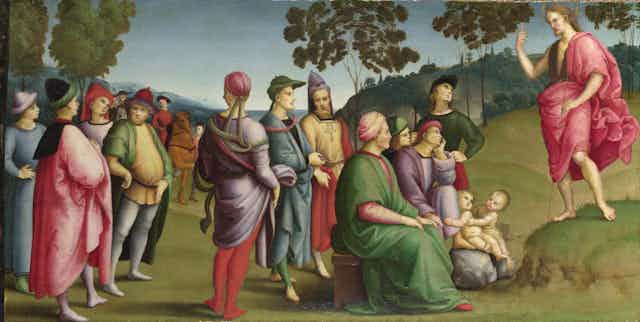How bountiful and benign heaven sometimes shows itself in showering upon one single person the infinite riches of its treasures, and all those graces and rarest gifts that it is wont to distribute among many individuals, over a long space of time …
Giorgio Vasari on Raphael, Lives of the Most Excellent Painters, Sculptors and Architects (quote from 1568)
Perhaps the best way to explore the lasting allure of the 16th-century painter Raphael – currently the subject of a blockbuster exhibition at the National Gallery in London – is to start with an explicit moment of rejection.
In 1848, a new group of painters who called themselves the Pre-Raphaelite Brotherhood identified the art of Raphael as a watershed moment for western art. They adopted the name “Pre-Raphaelites” to signal their movement’s intention to uphold the qualities that characterised Italian quattrocento art (art from the 15th century).
As far as the Pre-Raphaelites were concerned, the works of the Italian quattrocento artists – such as Raphael’s teacher Fra Bartolomeo, Masaccio, Fra Angelico and especially Sandro Botticelli – displayed painstaking attention to nature, and were characterised by meticulous attention to detail. All of this was arrayed in stunningly intricate and pleasing compositions; quattrocento art was considered simultaneously beautiful and truthful.
In stark contrast, the group viewed Raphael’s (and contemporaries Michelangelo and especially Correggio’s) work as mannered and over-executed. In their works, the brotherhood believed realism gave way to exaggerated poses, and attention to detail was eclipsed by an almost abstract emphasis on shapes and forms. Truthful attention to nature, they argued, was sidelined in favour of an overstated and overpolished idea of contrived “art”.

This rejection was best summed up by John Ruskin, the writer most closely associated with the Pre-Raphaelite Brotherhood. He lamented in 1845 that Raphael’s work in Rome was so perfect that it could only be followed by an inevitable period of decline:
The perfection of execution and the beauty of feature which were attained in these works and in those of his greatest contemporaries, rendered finish of execution and beauty of form the chief objects of all artists; and henceforward execution was looked for rather than thought, and beauty rather than veracity.
In other words, Raphael’s stylistic emphasis on beauty, serenity and grace had become an end in itself. Art became art for art’s sake and a manicured idea of a perfect ideal superseded an honest and truthful focus on nature.
As a result, Raphael has become easy to ignore. But it is this notion of palatable but superficial eye candy that the National Gallery’s exhibition, simply titled “Raphael”, seeks to challenge.
Man of many talents
There is certainly more to Raphael than blonde Madonnas and lush nudes. As well as being an accomplished painter, he was celebrated as a great architect. He delighted clients with monumental fresco ensembles and splendid sets of tapestries. He was a prolific draughtsman and printmaker, and was also in the process of compiling an archaeological survey of the monuments of Rome.

He headed up one of the most productive workshops in the city, which was able to turn its hand to commissions in any number of genres and media. Raphael was the consummate courtier and businessman, sustaining a workload none of his contemporaries could equal, while rarely compromising the quality of his work.
It was in fact that very “perfection of execution and beauty of feature” that marked these works; for Ruskin and the Pre-Raphaelites, this marked a watershed moment of decline. But for Raphael’s contemporaries, the grace, serenity and beauty of the works were the reason they were so desirable. For a 16th century patron, owning a work by Raphael was an important marker of their own identity and reputation.
In 1972, the art historian Michael Baxandall famously wrote that “a 15th-century painting is the deposit of a social relationship”. For his patrons, Raphael’s images signalled their belonging to an educated and privileged elite that shared moral and political values. In displaying their Raphael, they made this visible.
No other painter was able to satisfy this need in image-hungry Rome. Who was there? Michelangelo, the socially awkward loner happier with a chisel in hand than heading up a workshop? Leonardo? As Ruskin observed rather pithily in 1853, “Leonardo fretted his life away in engineering so that there is hardly a picture left to bear his name.”

Though he died relatively young (compared to some of his peers) at the age of 37 in April 1520, Raphael became synonymous with the image of Renaissance Rome in the way Hans Holbein has become synonymous with creating the likeness of Henry VIII. Easy to stereotype, easy to ignore, but well worth a second and even third look.
The triumph of the National Gallery exhibition is in bringing together these myriad aspects of Raphael’s output and inviting us all to look again.

